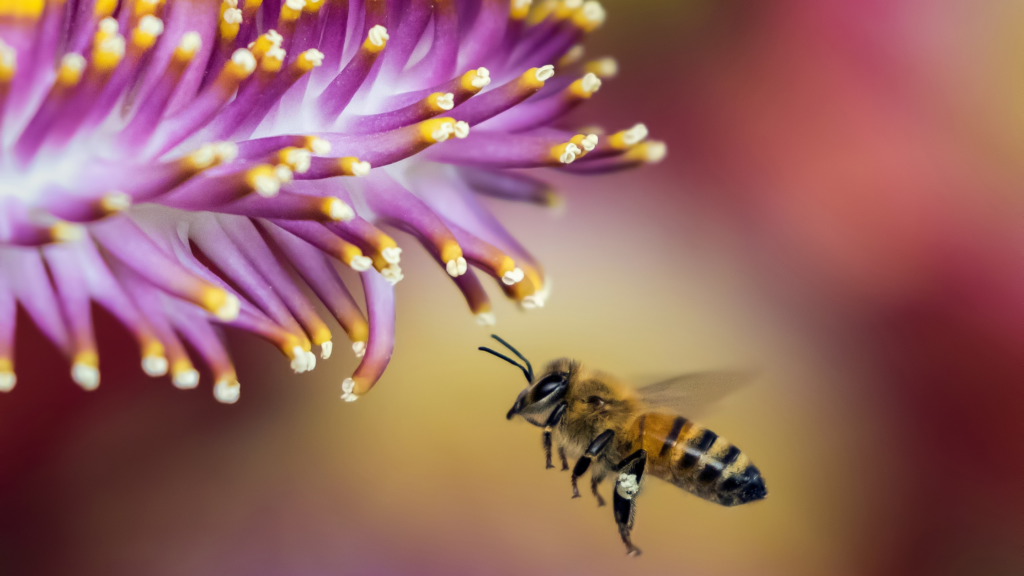Creating A Hospitable Yard for Pollinators: A Guide to Supporting Nature’s Essential Workers

The Importance of Pollinators
Pollinators play a crucial role in our ecosystem, contributing to the growth of many foods we rely on daily. Bees, butterflies, birds, and other pollinators pollinate around 75% of flowering plants and nearly 35% of global food crops. This includes a wide variety of fruits, vegetables, and nuts. However, the decline of pollinator populations significantly threatens our food supply and biodiversity. As a pest control company, we understand the delicate balance between maintaining a pest-free environment and supporting these vital creatures. Read on for tips on making your yard a pollinator haven and what to look for when choosing a pollinator-aware pest control provider.
Creating a Pollinator-Friendly Yard
Flowers & Shrubs
Choosing specific varieties of flowers and shrubs attracts many pollinators. Choose native plants that are well-suited to the local environment to provide the best resources for pollinators. Aim to have a variety of plants that bloom at different times of the year to provide consistent food sources. The varieties below can be found locally in Massachusetts:
Wildflowers
New England Aster (Symphyotrichum novae-angliae) – Blooms in late summer to fall, providing late-season nectar.
Purple Coneflower (Echinacea purpurea) – Offers nectar for bees and butterflies, and seeds for birds.
Black-eyed Susan (Rudbeckia hirta) – Attracts a variety of pollinators with its long blooming period.
Wild Bergamot (Monarda fistulosa) – Loved by bees and hummingbirds, it has a fragrant, minty aroma.
Butterfly Weed (Asclepias tuberosa) – Bright orange flowers that attract butterflies and bees.
Shrubs
Summersweet (Clethra alnifolia) – Fragrant white flowers that bloom in mid to late summer, attracting bees and butterflies.
Highbush Blueberry (Vaccinium corymbosum) – Provides nectar in the spring and berries for birds and wildlife in the summer.
Serviceberry (Amelanchier canadensis) – Early spring bloomer, providing one of the first nectar sources for bees.
Perennials
Bee Balm (Monarda didyma) – Vibrant flowers that attract bees, butterflies, and hummingbirds.
Joe-Pye Weed (Eutrochium purpureum) – Tall, late-summer bloomer that attracts butterflies.
Goldenrod (Solidago spp.) – A key late-season nectar source for many pollinators.
Herbs
Lavender (Lavandula spp.) – Aromatic flowers that attract a variety of pollinators.
Thyme (Thymus spp.) – Groundcover that blooms with small flowers, great for bees.
Oregano (Origanum vulgare) – Flowers that attract bees and butterflies, plus it’s a useful culinary herb.eties Found in Massachusetts.
Additional Yard Modifications
Provide Water Sources
Pollinators need water to thrive. A shallow dish with water, stones, or floating corks can provide a safe drinking spot. Birdbaths and small ponds also make excellent water sources for pollinators.
Create Shelter
Pollinators need places to nest and shelter from predators and harsh weather. You can provide nesting sites by leaving small patches of bare soil, installing bee hotels, or maintaining brush piles and deadwood.
Use Organic Mulch
Mulch helps retain soil moisture and suppresses weeds, creating a healthier environment for plants and pollinators. Organic mulch, such as wood chips or straw, is beneficial as it breaks down and enriches the soil over time.
Reduce Lawn Areas
Lawns provide little value to pollinators. Replacing parts of your lawn with flowering plants, shrubs, or trees can significantly increase pollinator habitat and food sources.
Balancing Pest Control and Pollinator Health
It is essential to maintain a balance between effective pest control and the health of pollinators. At Ecologic Entomology, we prioritize both by adhering to strict guidelines and employing best practices in our pest management strategies. Our commitment to pollinator health is genuine and deeply rooted, as our Principal and founder Jonathan Boyar, is a dedicated beekeeper who understands these creatures’ critical role in our ecosystem.
Following Manufacturer Labels
Our technicians strictly follow all manufacturer labels and recommendations when applying pesticides. These labels provide critical information on proper usage, including the correct dosage, application methods, and safety precautions to minimize harm to non-target organisms such as pollinators. By adhering to these guidelines, we ensure that our treatments are both effective and environmentally responsible.
Technician Training
Our technicians undergo comprehensive training to understand the importance of pollinators and the best practices for protecting them. This training includes:
Identifying Pollinator Activity
Technicians are trained to recognize areas of high pollinator activity, such as flowering plants and trees, and to take extra precautions in these areas.
Integrated Pest Management (IPM)
Emphasizing non-chemical methods first, such as cultural, physical, and biological controls, and using chemical treatments only when necessary.
Targeted Application
Focusing product applications on specific pest problems rather than broad-spectrum spraying helps minimize the impact on beneficial insects.
Meticulous Adherence to Product Application
To further protect pollinators, we meticulously adhere to precise application techniques, including:
Avoiding Flowering Plants and Trees
We refrain from applying products near flowering plants and trees, which are common foraging sites for pollinators. This reduces the risk of direct exposure to harmful chemicals.
Timing Applications
Products are applied during times when pollinators are less active, such as early morning or late evening. This helps reduce the likelihood of pollinators coming into contact with freshly applied products.
Buffer Zones
Establishing buffer zones around known pollinator habitats and areas with established honey bee activity ensures that these critical areas remain protected during pest control treatments.
By combining these practices with our commitment to responsible pest management, we can effectively control pests while safeguarding the health and vitality of pollinators. At Ecologic Entomology, we understand the importance of preserving the balance of our ecosystem and are dedicated to implementing strategies that protect both your home and our invaluable pollinators.
